Easy Sourdough Starter Recipe Using Yogurt Whey
Sneak Preview: Make this Sourdough Starter Recipe using yogurt whey. After 5-10 days, it should be bubbly and strong enough to bake a loaf of sourdough bread. You can collect yogurt whey from store-bought yogurt, but if you’re a Greek yogurt maker, this is a great use for leftover yogurt whey.
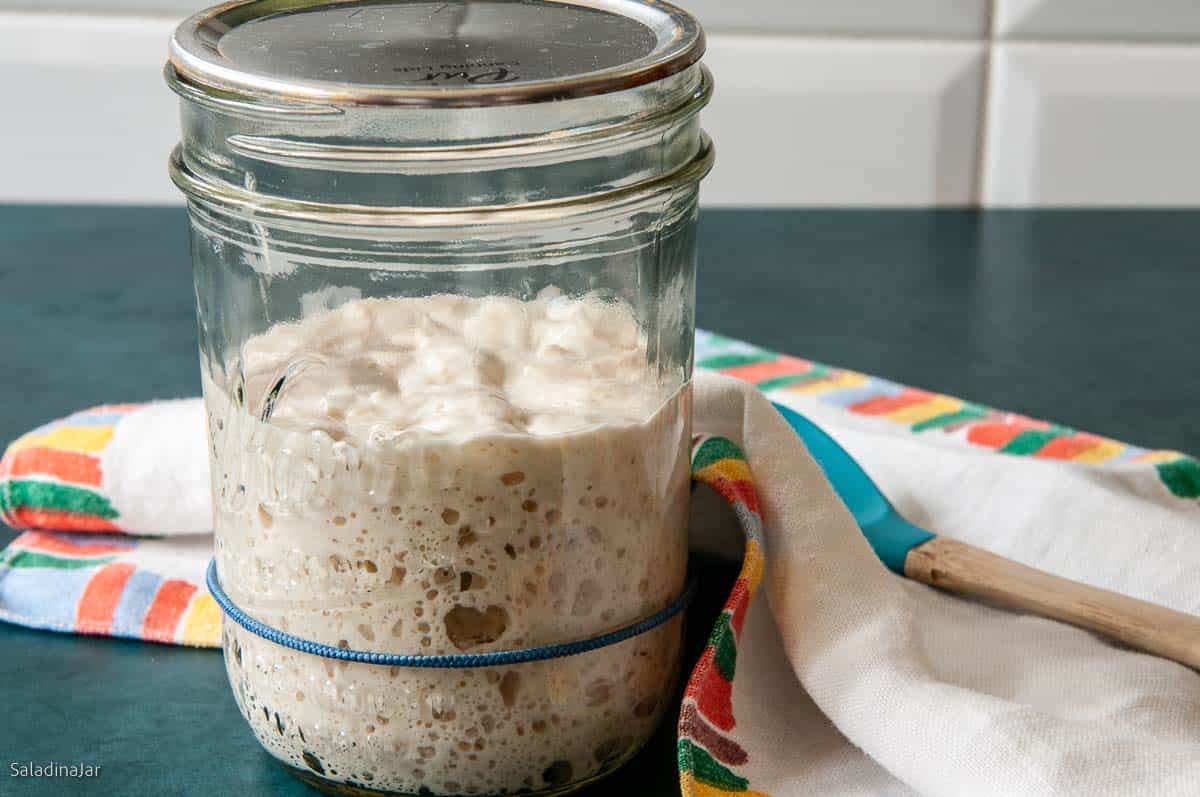
As an Amazon Associate, I earn from qualifying purchases.
Making a sourdough starter is not complicated. I used to think so, but now I know better. I’ll show you my easy way of using yogurt-whey and all-purpose flour to make a sourdough starter.
Are you thinking to yourself, “What is yogurt whey?” and where do I buy it?
Yogurt whey is different from the whey protein powder many people throw into their smoothies. Whey protein powder is more often made with egg whites.
Happy Bakers Speak Up
“Thank you so much for the easy to follow instructions! I’ve tried lots of starters with varying success, but yours has been the easiest and most successful recipe! My starter was bubbly and strong in no time. I love that there is so little waste! I did save the discard and made the best tasting crackers. Thank you so very much for sharing this great method with us!”–CASSIE
Why Use Yogurt Whey To Make a Sourdough Starter? u
Yogurt whey is loaded with lactic acid, an important component of sourdough starter. Although a sourdough starter can be made with straight water and flour, adding whey to the initial flour/water mixture will boost the bubbles and fermentation from day one.
Some people claim that yogurt whey imparts a unique flavor to your sourdough bread. But you will only use whey the first day you stir together a starter mixture, so it won’t be long before the whey flavor is unrecognizable. If you use yogurt whey as a substitution for water in a bread recipe, your bread probably will taste different.
As you build the strength of your starter, you will discard half, then three-quarters of the starter every day before adding more water and flour. The original dose of whey will be quickly diluted.
Where Do I Find Yogurt Whey?
Many of my readers make Greek yogurt at home, so it’s already in our refrigerators.
You might think you’ve never seen liquid yogurt whey for sale at the grocery store. But you have.
Oftentimes, you’ll see a small amount of whey collecting on top inside a container of commercial yogurt. The whey is waiting to be poured out or stirred back in before eating. Yogurt whey looks clear in the yogurt container, but a large quantity looks yellow.
If you buy yogurt to harvest whey, look for these three things:
- Plain yogurt, not flavored or sweetened in any way
- No additives that cheaper brands use to make their yogurt look and feel thicker
- The freshest yogurt you can find
How Do I Separate Yogurt Whey From Commercial Yogurt?
Buy a pint of regular unflavored yogurt at the store. Strain it through a paper coffee filter placed inside a sieve or colander. It may take 1-2 hours to obtain enough whey. You only need 40 grams or 3/8 of a cup (3 tablespoons).
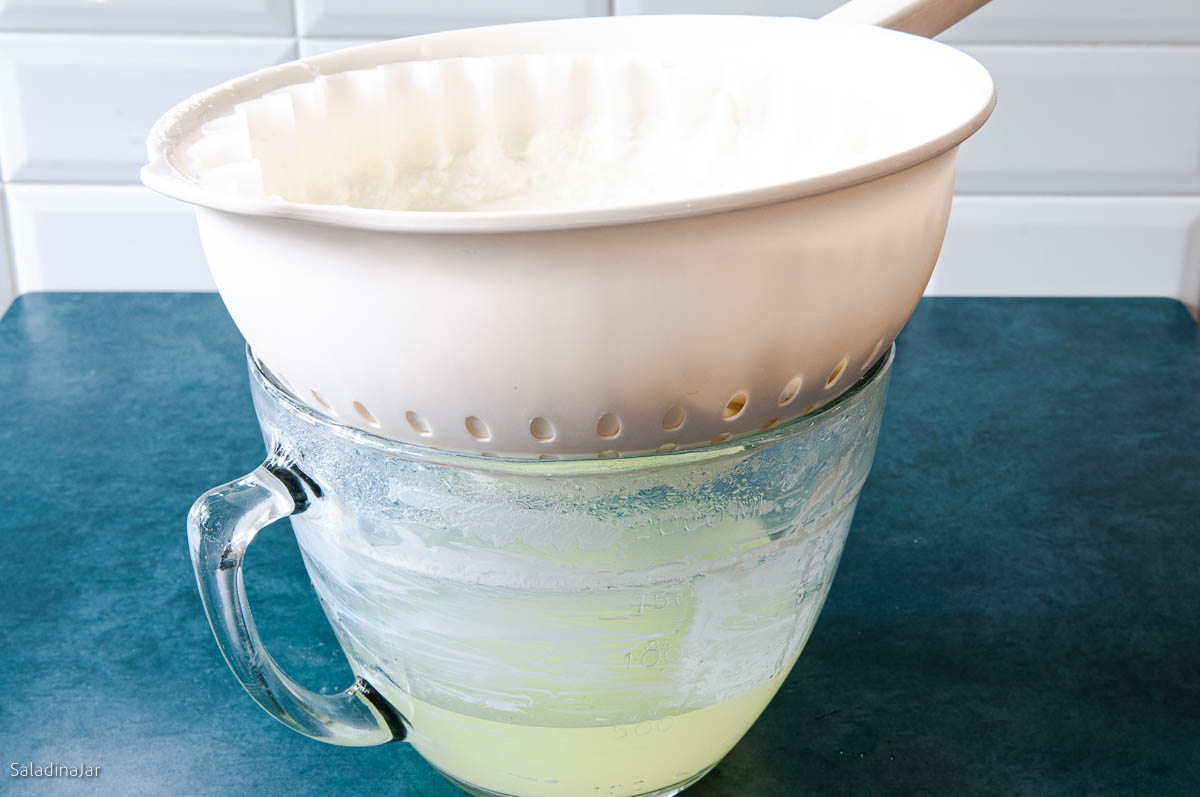
What Do I Need To Make a Yogurt Whey Starter?
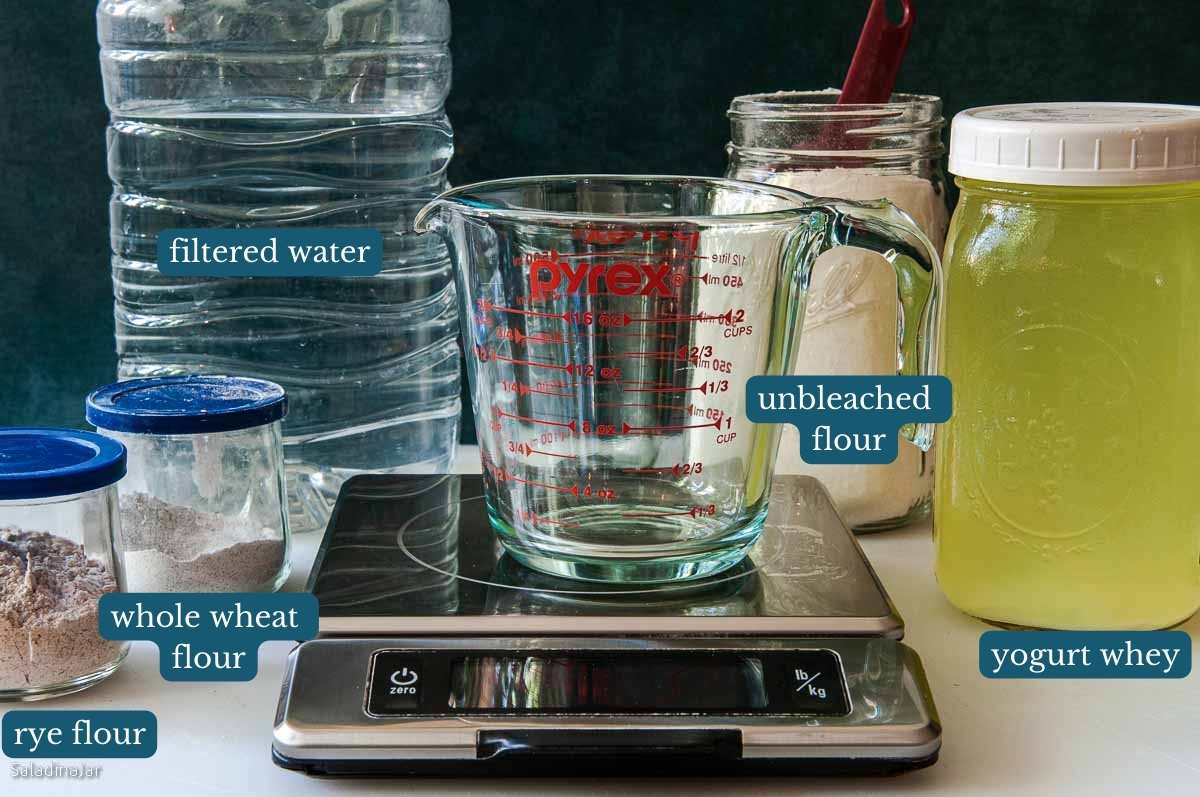
- Flour, yogurt whey, and filtered water (See FAQs below for substitutes)
- Mason glass jar (quart-size) or a medium ceramic bowl
- Cover such as a flat metal canning lid for a Mason Jar or a glass lid that fits loosely
- Warmth–to encourage your starter to bubble–preferably 75-85˚F
- Time–4-7 days, depending on the environment
Do I Have To Add Whole Wheat Flour and Rye Flour?
Absolutely not, but I highly recommend it. I call them “vitamins” for my starter. Along with the whey, they will supercharge your starter because whole-grain flour naturally carries more wild yeast. Without it, your starter may take a little longer to get up to speed.
How Do You Make a Sourdough Starter with Yogurt Whey?
Day One
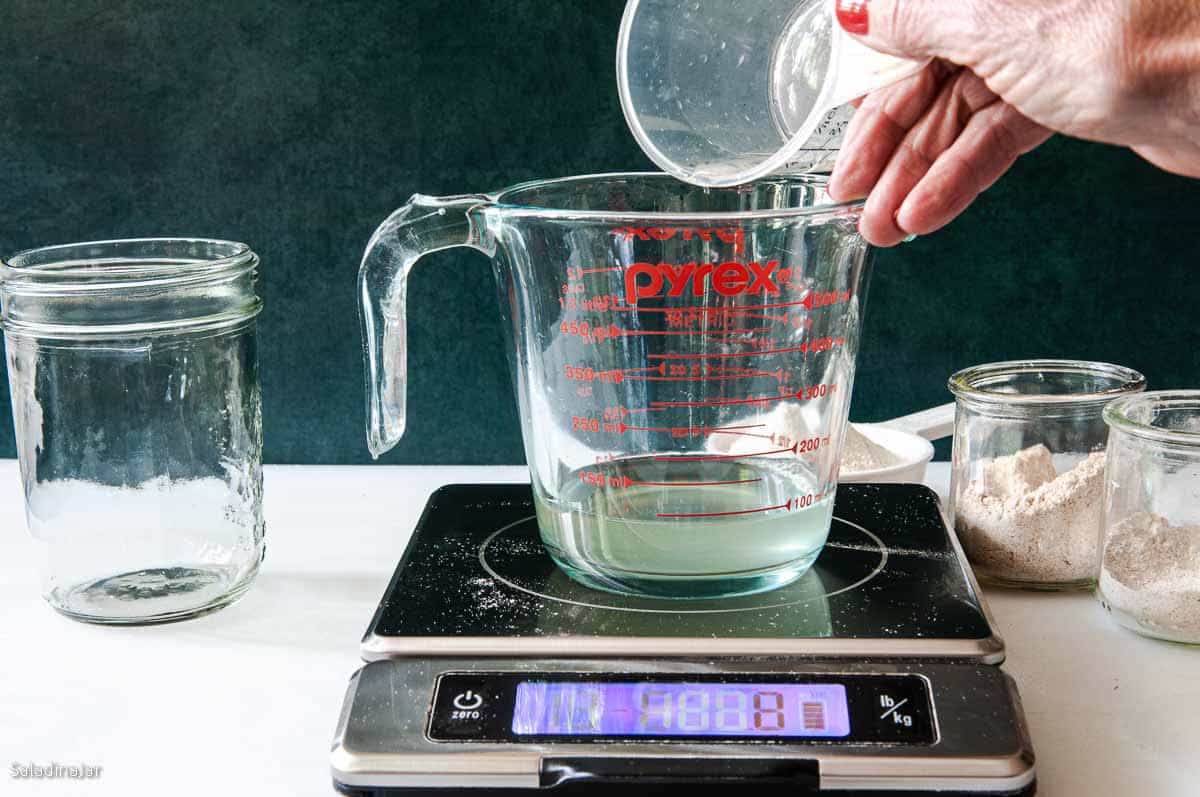
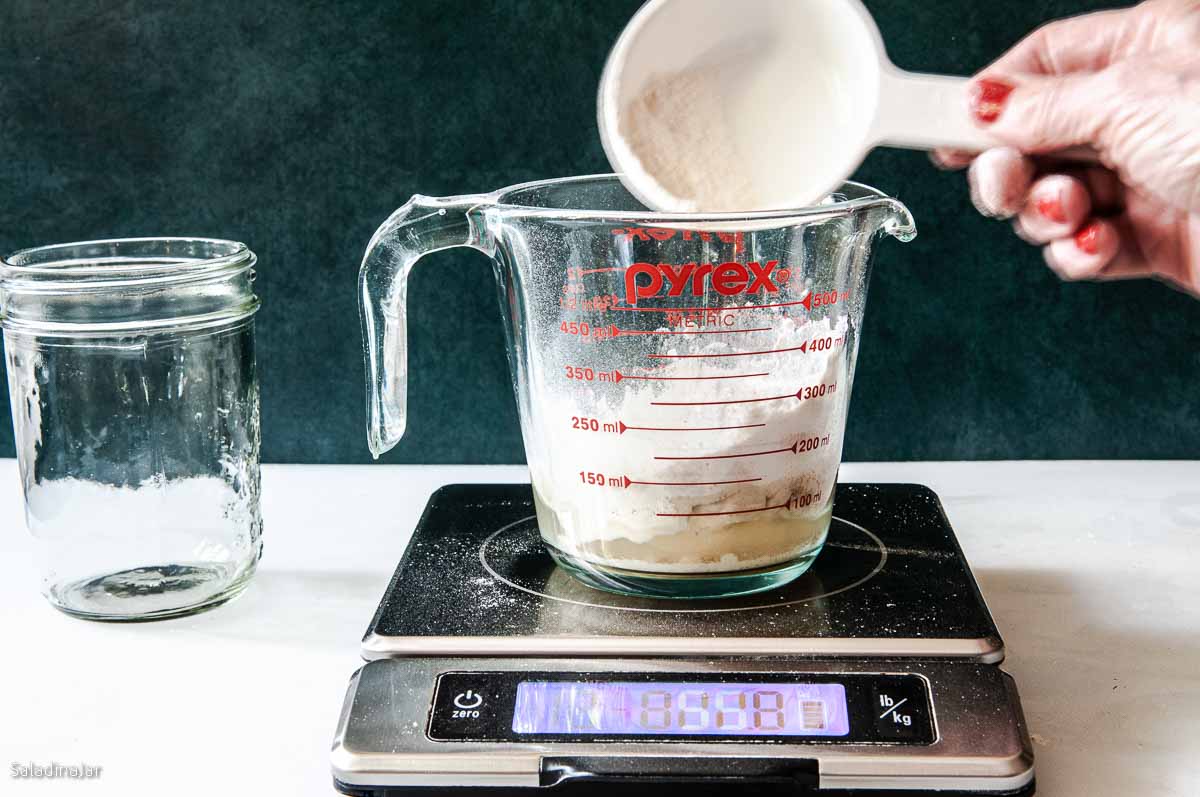
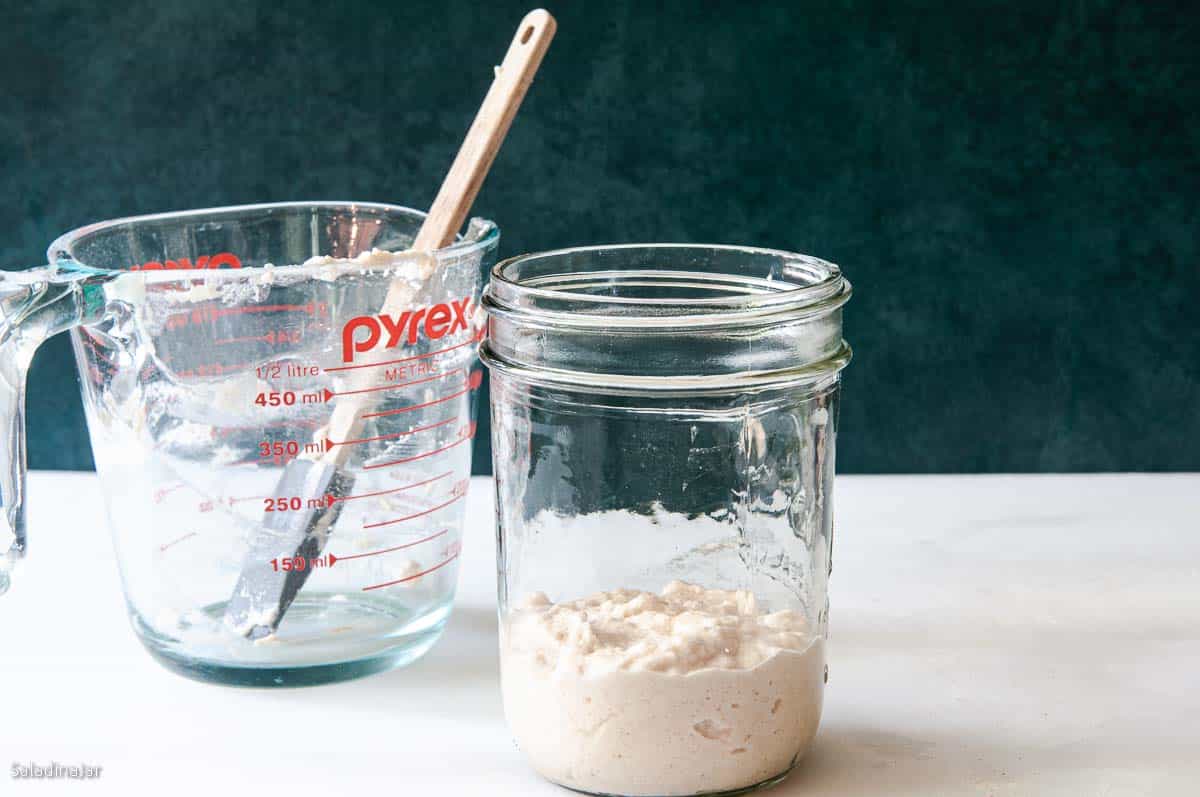
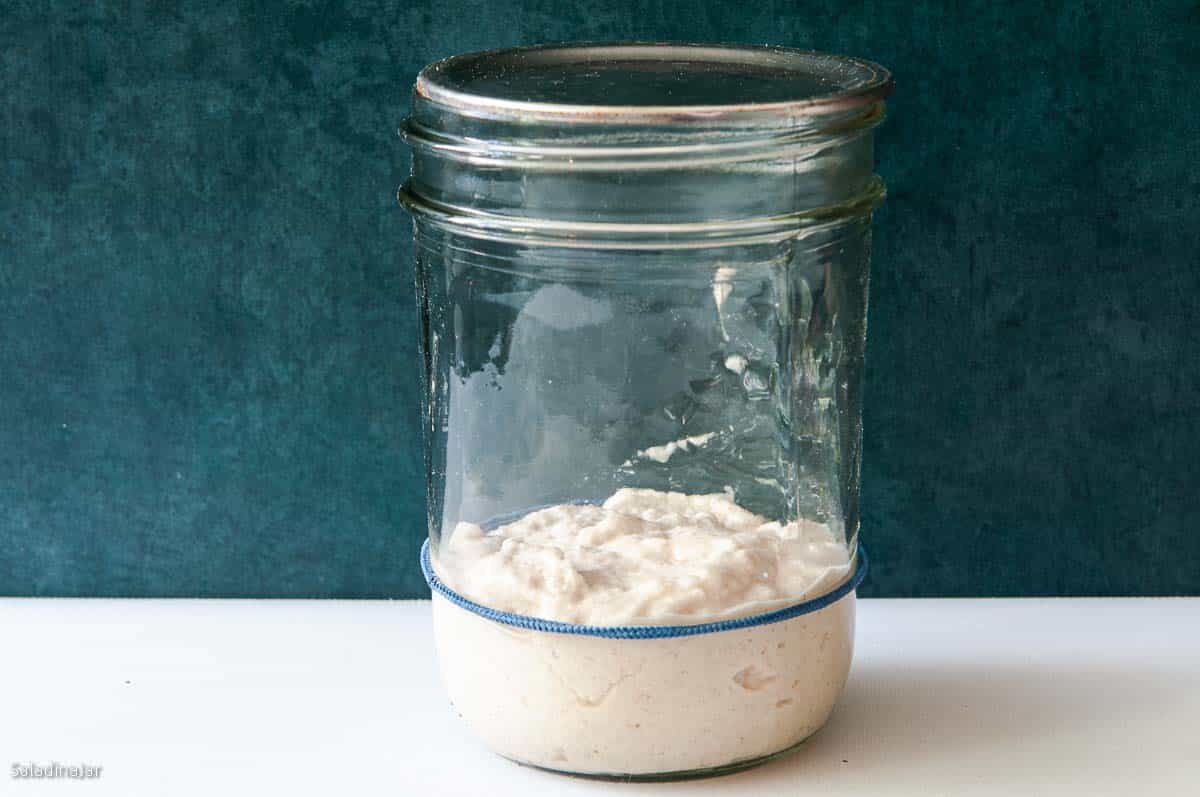
If using a Mason jar, lay a flat canning lid on top. You don’t need the metal collar for now. If you don’t have a lid for your glass jar, throw a tea towel or plastic wrap loosely over the bowl or jar to keep out foreign objects such as dust or small flying insects.
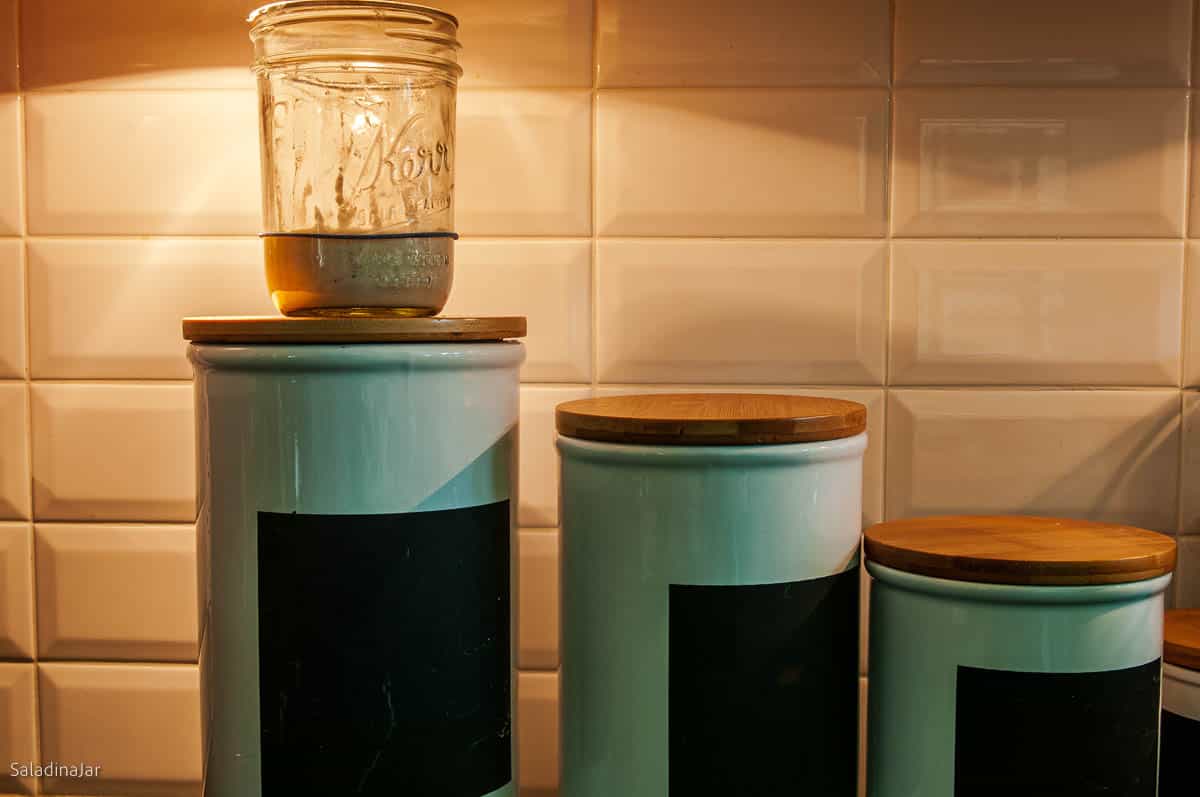
I put mine close to my lights installed under the upper cabinets. The temperature is crucial in making a sourdough starter and sourdough bread. You need a quick-read digital thermometer. It doesn’t have to be expensive, but if you buy a good one, you’ll use it daily if you cook or bake a lot.
Let the starter sit undisturbed for 24 hours.
Day Two
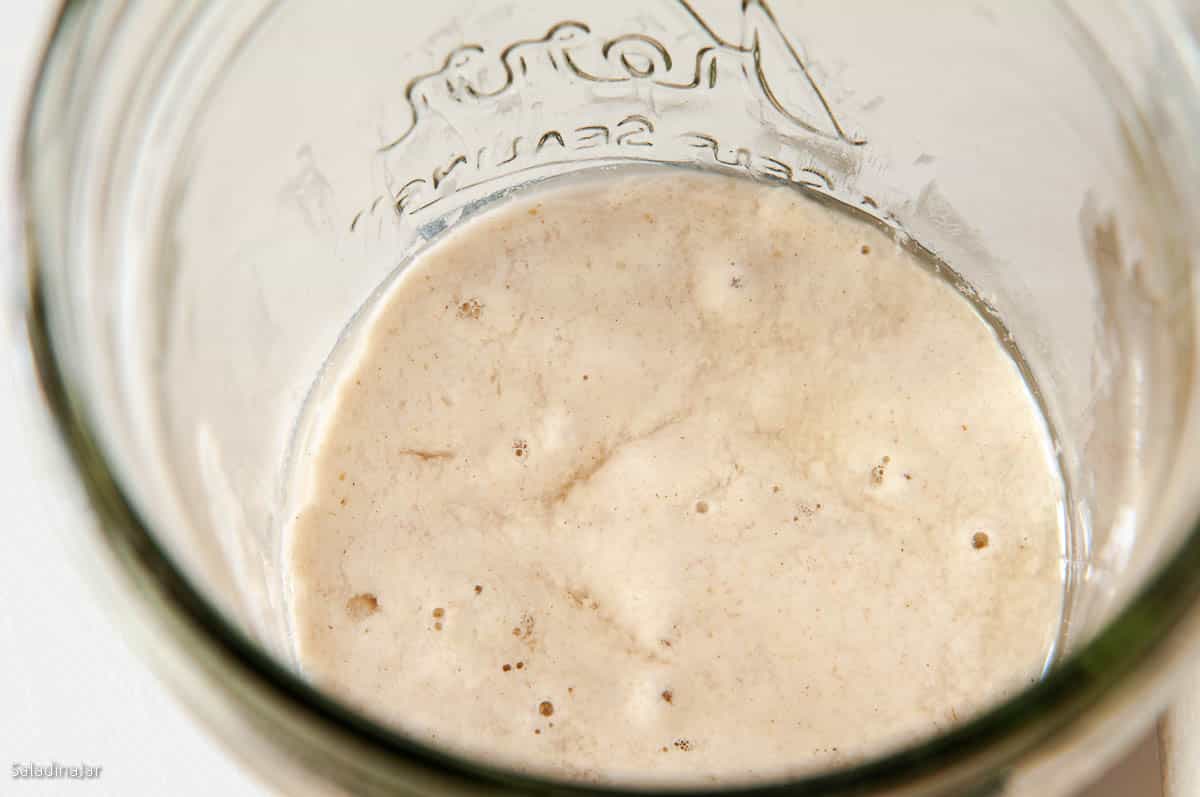
Stir the starter. Remove half of the starter mixture and throw it away. It won’t have a good flavor yet, even for “discard” recipes. Add 40 gr of water and 40 gr of flour to the remainder of the starter left in the jar. Let it sit in a warm location for another 24 hours.
Day Three
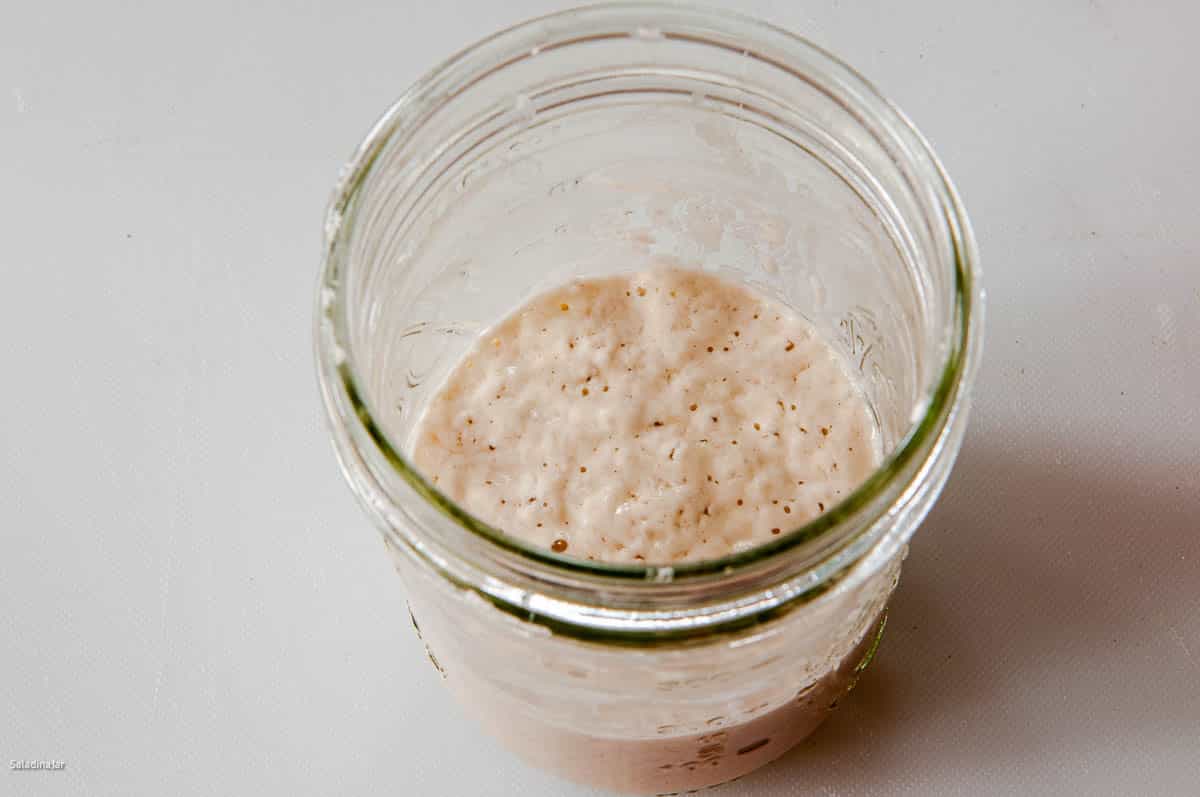
Repeat Day Two.
Day Four
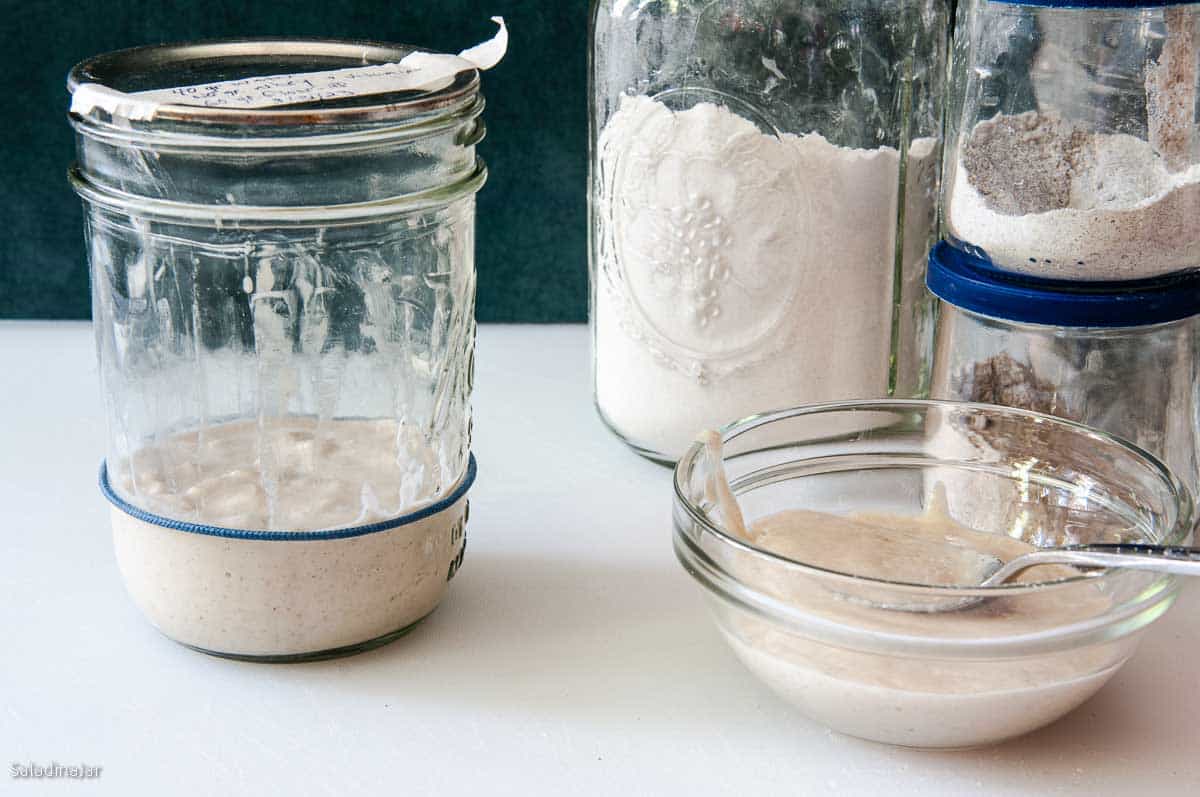
Stir the starter. Remove approximately three-quarters of the starter mixture until you have only 25 grams of starter left in the jar. (I make a note of the weight of an empty jar. Add 25 grams to that number.) This will look like a tablespoon or so. Add 25 grams of water, 25 grams of flour, a pinch of rye flour, and a pinch of whole wheat flour.
Stir to moisten all flour. Place the mixture back in a warm location.
Day Five and Six
Repeat day four, but do it twice a day every 12 hours. Your starter should be quite active by now, rising more each day, then falling back to the rubber band level eventually.
Day Seven
If your starter matures within 4-5 hours, it is probably strong enough to make bread. From now on, it’s your preference to refresh the starter every 12 or 24 hours.
If your starter takes more than 5 hours to mature, continue with the twice-daily feedings. You may need to find a warmer location for your starter to incubate if your starter isn’t active by now.
If you are not ready to make bread just yet, store the starter in the fridge. Remember to refresh it (Step 4) about once a week.
Ready To Make Bread?
- Four to five hours before making bread, discard all but one tablespoon of the starter. (Eyeball it.)
- Add 60 grams (¼ cup) of filtered or tap water and 60 grams (½ cup) of unbleached all-purpose flour to the starter, along with a pinch of rye and whole wheat flour (optional). Stir, cover, and let your starter sit in a warm place.
- When the starter mixture bubbles up to its full potential (double or triple in size) after 2-6 hours, measure the starter you need for your recipe. You can try the float test, although it’s not always reliable. Drop a small spoonful of starter into a bowl of water. When your starter is ready, it should float.
- Replenish the starter with 1 tablespoon of the remaining starter (discard the remainder), ¼ cup of water, and ½ cup of AP flour. Stir and set aside in a warm place.
If you don’t want to make another loaf for several days, wait until the starter begins to grow (an hour?), then refrigerate. It’s best to use or refresh your starter at least once a week. Once a month is a minimum.
If, at any point, you see mold or funky colors appear in your starter, throw it away and start over again.
A Quick Guide To Making a Sourdough Starter with Yogurt Whey
Pin it to remember it.
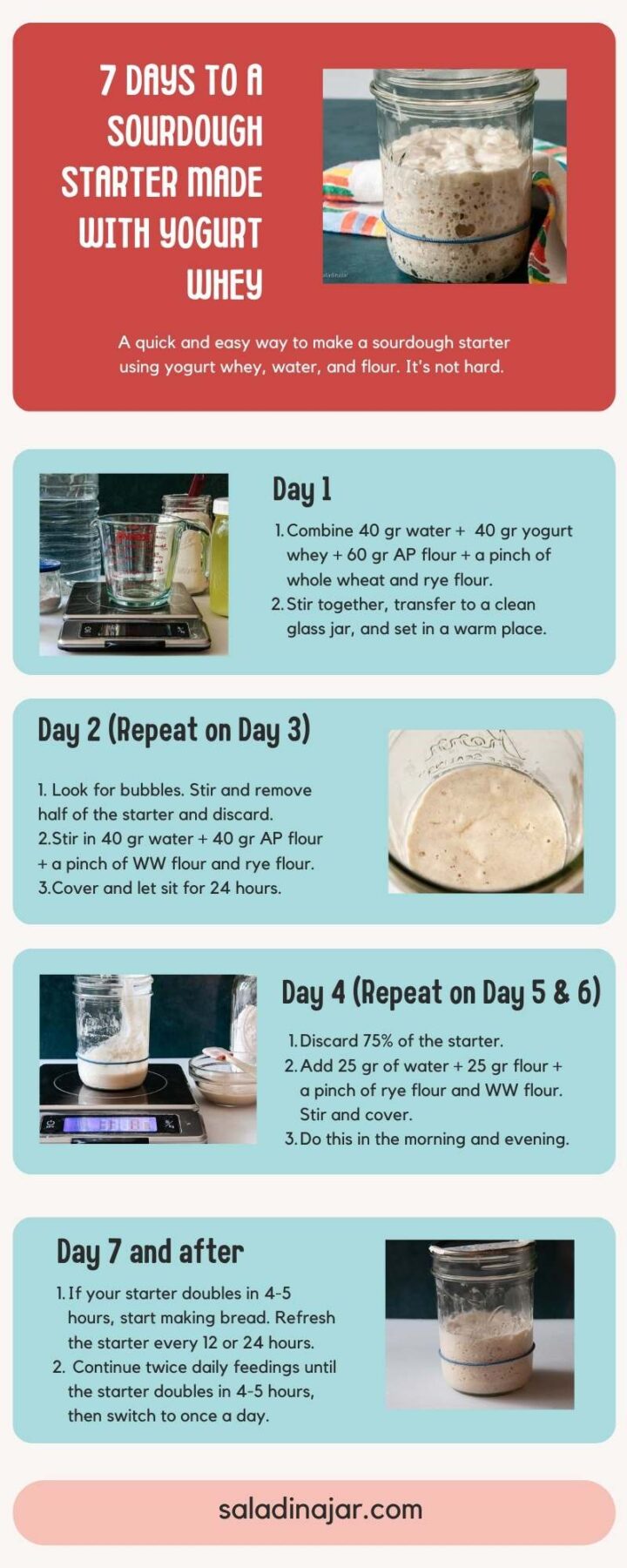
FAQ About Yogurt Whey Starter
More often than not, the temperature is not warm enough for the yeasty bodies to feel like eating. Try to keep the temperature as close to 80˚F as possible without going over, especially during the first three to four days.
Two reasons:
1. In the beginning, the bacteria count will likely be out of balance. It takes a few days for the good bacteria to take over. Removing part of the starter also removes a good deal of the waste products that make sourdough bread too sour. You will know by the smell who is winning the war.
2. If you were to keep all the flour and water you used in this process, you would need a much bigger jar. As it is, you only need a pint-size glass jar.
I don’t like to waste flour, even though I use the cheapest all-purpose flour I can find. The smaller amounts work fine. When you actually begin to use the starter for baking bread, you can increase the amount of flour and water to produce the amount of starter required in the recipe you chose. Likewise, if you need more “discard” for a specific recipe.
Some people use a jar that’s too small and wait until it overflows before taking a picture. After a week, more or less, your starter should double or triple in size before it starts to fall. Choose a jar that will accommodate plenty of rise if your starter is active and strong.
Another reason a starter may overflow in a jar is the proportion of water to flour. If your starter is too “liquidy,” it may grow faster and higher, but it may not be strong enough to support a loaf of bread. High humidity and higher temperatures also make this more likely.
I would wait for at least 6-7 days. One way to know if your starter is ready is to smell it. Does it smell sour and slightly sweet, or is it pungent and sort of like fingernail polish remover? If you are a new baker, this can be hard to judge. But if you keep smelling your starter every day, you will develop a sixth sense regarding the health of your starter.
Yes. On the first day, add one tablespoon of yogurt to enough nonfat milk (reconstitute powdered milk or use fresh) to measure ½ cup. Add ½ cup of unbleached, all-purpose flour, a pinch of whole wheat flour, and a pinch of rye flour. Follow the recipe directions going forward.
Generally, yes, as long as your water is not heavily mineralized.
Yes. Just about any flour will work. Organic flours are excellent if they are available to you and you don’t mind the price. Whole wheat and rye flour are other choices that make a great starter if you like the taste. Because of the cost and my affinity for white flour, I add only a pinch of rye and whole wheat to my starter as “vitamins” to keep my starter full of energy.
Large holes tend to develop in thicker starters. Starters with more water in proportion to the flour tend to have smaller holes. Starters can be thick or thin depending on the ratio of flour to water used to maintain it. Some people use equal amounts (by weight) of water and flour. Others use more flour (by weight) than water. The more water you use, the faster the starter rises and the more often you will need to refresh your starter.
Parting thoughts: Looking for a Sourdough Sandwich Bread you can make with your bread machine? Try this Sourdough Bread Machine Sandwich Loaf. Check out my three-ingredient Sourdough Bread Machine Recipe – No Yeast for a classic sourdough loaf. If you want to test your starter, this Chewy Sourdough Dinner Rolls recipe is the easiest.
Recipe Help at Your Fingertips: For questions or suggestions, email Paula at saladinajar.com. If you need help, I’m happy to troubleshoot via email (faster than leaving a comment). Attach pictures and as many details as possible for the best advice.

Sourdough Starter Made with Yogurt Whey
Rate this recipe
(5 stars if you loved it)
Ingredients
What you need on day one:
- 3 tablespoons water–filtered or tap 40 gr
- 3 tablespoons yogurt whey 40- gr
- ½ cup all-purpose white flour 60 gr
- 1 pinch whole wheat flour (optional)
- 1 pinch rye flour (optional)
Instructions
- DAY ONE: Add 40 gr of water, 40 gr of yogurt whey, and 60 gr of unbleached all-purpose flour to a small bowl or a one-pint measuring cup.
- Stir together well with a plastic spatula, ensuring all flour is moistened.
- Transfer the mixture to a clean glass pint jar or a small ceramic bowl. Cover loosely. Set aside in a warm place. The optimum temperature is 78-80˚F (25-26˚C). If it’s colder, it will take longer for the starter to get going. Much warmer, and the yogurt bacteria could die or at least, take a siesta.
- DAY TWO: Hopefully, you will see bubbles. Even if you don’t, stir the starter, remove half of it and throw it away. Stir in 40 gr of water + 40 gr of AP flour + a pinch of rye, and a pinch of WW flour. Cover and let sit in a warm place for 24 hours.
- DAY THREE: Repeat Day Two. Note: If you still aren’t seeing bubbles, move your jar to a warmer location.
- DAY FOUR: Discard 75% of the starter. Add 25 gr of water and 25 gr of AP flour + a pinch of rye, and a pinch of WW flour. Stir and Cover. Do this in the morning and evening.
- DAY FIVE: Repeat day four.
- DAY SIX: Repeat day five.
- DAY SEVEN and after: If your starter doubles in 4-5 hours, start making bread. If not repeat day 4 until it does.
- Maintenance: Continue twice daily feedings until the starter doubles in 4-5 hours, then switch to once a day. When you need a break, place the starter in the fridge. Refresh at least once a week when storing it in the fridge. When you are ready to make bread again, remove it from the fridge, and repeat day 4 for 1-2 days to get your starter back up to speed.
Notes
Nutrition
All images and text ©️ Paula Rhodes for Salad in a Jar.com



Paula Rhodes, owner
As a retired home economist, I created Saladinajar.com to share my belief that you don’t have to be a chef to find joy in creating homemade food worth sharing. Bread machines (used in an unconventional way), homemade yogurt, and quick microwave recipes are my specialty.